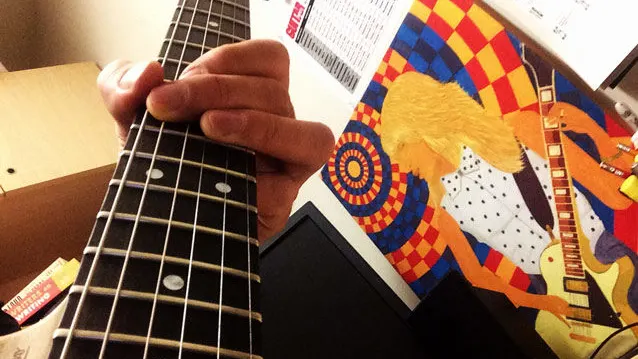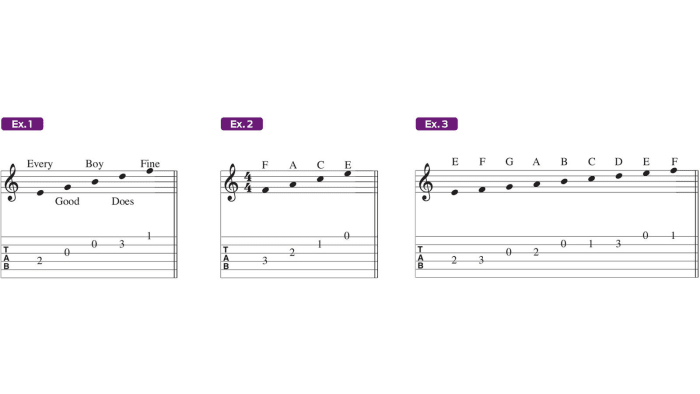Learn to Read Music with This Easy Lesson
You may not necessarily ~need~ to know how to read music to play music, but it certainly helps! Get started with this lesson.

If studied with any kind of concentration and regularity, this lesson will teach you how to read music.
That’s right.
No more screwing around.
You will finally be able to read music. Not tablature (even though tab is a big help and we’ll still use it). Standard notation. Those hieroglyphic dots and lines from the days of yore. The secret code that, once you break it, will allow you to play any piece of music from any time in history. How freaking empowering is that?
Before we begin, this might be a good time to address the deafening chorus of objections that are currently being screamed in guitarists’ heads worldwide.
YOU DON’T NEED TO KNOW HOW TO READ MUSIC TO PLAY MUSIC
Very true. You don’t need to know how to read music. You also don’t need to know long division, how to sing, how to speak a foreign language, or how to change your oil. But all of those skills are undeniably valuable. If you don’t want to learn a new skill, those things—and this column—are not for you.
JIMI DIDN’T READ
No he didn’t. Nor did a huge number of great players. But here’s a newsflash: You’re not Jimi (or SRV or Paul McCartney). Wouldn’t it be cool to be able to do at least one thing on guitar that Jimi couldn’t do?
READING MUSIC WILL MAKE ME LOSE MY EXPRESSIVITY
No it won’t. Did learning how to read words inhibit your ability to talk? Okay then.
So those are some of the reasons to not learn how to read. Why, then, do players like Steve Vai, John Scofield, Brian Setzer, Paul Gilbert, Sharon Isbin, and Steve Lukather even bother? Because being able to read standard notation kicks ass, that’s why. If you can read even just a little bit, you will have a greater knowledge of music in general and your guitar in particular. Reading notation will force you to think about rhythm, dynamics, ornamentation, space, vibrato, and tempo more than ever before. Tab tells you where to put your fingers. Notation tells you when, how long, and how hard to play a note, and what to do to that note after you hit it. It’s amazing how much information is contained in just one bar of written music. That’s also what can make it intimidating, but fear not. We’re not only going to begin at the beginning, we’re going to go through this in the most guitarist- friendly way possible. So let’s do it.
The concepts we need to concentrate on for starters are pitch, time, and duration: what note you’re hitting, when you’re hitting it, and how long you’re holding it. Those three things pretty much make up music, don’t they?
We need to start with a couple of age-old mnemonic devices to start understanding these magical little dots.

Every Good Boy Does Fine. Say it. These are the notes on the lines of the staff, as in E, G, B, D, F in Ex. 1. Now say FACE. Those are the notes in the spaces of the staff: F, A, C, E as seen in Ex. 2. (Savvy readers probably figured out that if you combine those two groups of notes [Ex. 3], you’ll get E, F, G, A, B, C, D, E, F, low to high.) Etch these in your brain. They’re your foundation and will also be invaluable when it comes time to read above and below the staff.
Now we’re going to meet our friend the quarter-note. He has a filled in black dot and a stem. We will learn about his siblings soon enough, but the quarter-note is enough to get you reading right now. You play one quarter-note on each beat or every toe-tap, in this case four per bar. Start with the E on the bottom line (as in “Every”) that you can play at the 2nd fret of your D string, and pick it once per beat for two bars in Ex. 4.

Guess what? You can now read music. I’m not kidding. If you can do that, you can read anything, although most things will be more difficult than this. That’s okay, though.
Now let’s add the Good Boy Does Fine notes for Ex. 5. Because we have options as to where we play notes on the guitar, it’s helpful to glance at the tab to get your bearings, but then look only at the notes. Play them, one per beat, and say the note names (or even the Every Good Boy stuff). Now play the FACE notes [Ex. 6], which add up to a nice Fmaj7 chord. Now play them all sequentially in Ex. 7, saying the note names as you go.

For your final exam on this lesson we go with no tab, and it’s up to you to decipher this well-known melody. One note per beat with rests (or silence) on beats two and four of the last bar. Recognize it? You just read that! Doesn’t that feel good?

Get The Pick Newsletter
All the latest guitar news, interviews, lessons, reviews, deals and more, direct to your inbox!
“Write for five minutes a day. I mean, who can’t manage that?” Mike Stern's top five guitar tips include one simple fix to help you develop your personal guitar style
"It’s like you’re making a statement. And you never know where it’ll lead." Pete Thorn shares the tip that convinced Joe Satriani he was the right guitarist for the SatchVai Band










